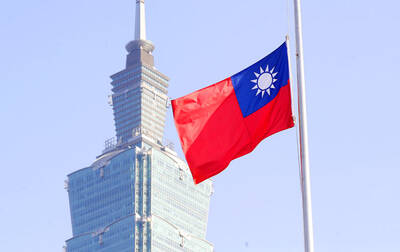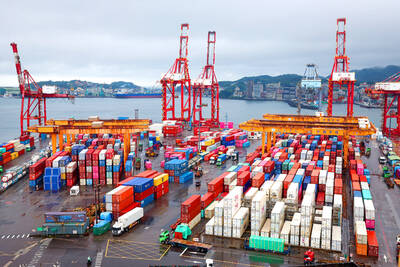Traders are swarming to equity-focused, exchange-traded funds (ETFs) listed in Taiwan, with demand from retail investors and a strong local currency driving up flows.
Taiwan-listed equity ETFs have attracted more than US$19 billion in inflows this year, the most among their regional peers, data compiled by Bloomberg Intelligence showed. That was more than the inflows into products listed in South Korea and China combined, and nearly the entire amount Taiwanese ETFs brought in for all of last year.
The big inflows highlight the increasing power of Taiwanese retail investors.

Photo: Ritchie B. Tongo, EPA-EFE
While the nation’s shares have seen foreign outflows of US$3 billion this year, the fourth-most in Asia, the benchmark TAIEX is only down about 2 percent, Bloomberg data showed. A rally in the New Taiwan dollar is also supporting investments in local currency, with a “Sell America” rotation fueling expectations for further gains.
“Inflows into Taiwan stock ETFs usually increase when the market pulls back, as local investors prefer buying on dips,” Cathay Securities Investment Trust Co (國泰投信) chief investment officer Eddie Cheng (鄭立誠) said.
They have also grown, “as investors shift away from US dollar assets and turn to Taiwan stocks,” he added.
Taiwan’s biggest equity ETF has garnered US$6.2 billion in inflows, the most in the region this year. The surge followed a fee reduction and share split that could lower prices for retail investors. Its almost 60 percent weighting in Taiwan Semiconductor Manufacturing Co (台積電), the world’s largest contract chipmaker, also helped lure investors.
“Taiwanese’s overall confidence in TAIEX and the chip industry is still fairly strong,” spurring traders’ interest in local ETFs, Yuanta Securities Investment Trust Co (元大投信) chairman Julian Liu (劉宗聖) said.
About 2 million local investors participate in investment plans that make contributions in regularly fixed amounts, which can bring about NT$15 billion (US$516.39 million) of inflows into TAIEX ETFs every month, Liu added.
Total assets in Taiwan’s broader ETF market surged 64 percent to NT$6.4 trillion last year and now rank third in the region, according to industry data and Bloomberg Intelligence. Equity and fixed-income products make up most of those ETFs.
The strong inflows are likely to continue.
Taiwan’s developed retail market and sophisticated investors could help local ETFs grow much quicker than the rest of the region, Bloomberg Intelligence senior analyst Rebecca Sin (冼素君) said.
Regulators are implementing measures to supercharge the vast-growing sector. Officials recently greenlit cross-listed ETFs between Taiwan and Japan, which allow products to list in both locations.
At the same time, foreign investors have been repeatedly buying Taiwan’s ETFs to speculate on the local currency.
The central bank is seeking feedback on a plan to tighten currency purchases by overseas stock investors.
Still, most demand comes from retail investors, who buy ETFs as a long-term investment.

ELECTRONICS BOOST: A predicted surge in exports would likely be driven by ICT products, exports of which have soared 84.7 percent from a year earlier, DBS said DBS Bank Ltd (星展銀行) yesterday raised its GDP growth forecast for Taiwan this year to 4 percent from 3 percent, citing robust demand for artificial intelligence (AI)-related exports and accelerated shipment activity, which are expected to offset potential headwinds from US tariffs. “Our GDP growth forecast for 2025 is revised up to 4 percent from 3 percent to reflect front-loaded exports and strong AI demand,” Singapore-based DBS senior economist Ma Tieying (馬鐵英) said in an online briefing. Taiwan’s second-quarter performance beat expectations, with GDP growth likely surpassing 5 percent, driven by a 34.1 percent year-on-year increase in exports, Ma said, citing government

‘REMARKABLE SHOWING’: The economy likely grew 5 percent in the first half of the year, although it would likely taper off significantly, TIER economist Gordon Sun said The Taiwan Institute of Economic Research (TIER) yesterday raised Taiwan’s GDP growth forecast for this year to 3.02 percent, citing robust export-driven expansion in the first half that is likely to give way to a notable slowdown later in the year as the front-loading of global shipments fades. The revised projection marks an upward adjustment of 0.11 percentage points from April’s estimate, driven by a surge in exports and corporate inventory buildup ahead of possible US tariff hikes, TIER economist Gordon Sun (孫明德) told a news conference in Taipei. Taiwan’s economy likely grew more than 5 percent in the first six months

SMART MANUFACTURING: The company aims to have its production close to the market end, but attracting investment is still a challenge, the firm’s president said Delta Electronics Inc (台達電) yesterday said its long-term global production plan would stay unchanged amid geopolitical and tariff policy uncertainties, citing its diversified global deployment. With operations in Taiwan, Thailand, China, India, Europe and the US, Delta follows a “produce at the market end” strategy and bases its production on customer demand, with major site plans unchanged, Delta president Simon Chang (張訓海) said on the sidelines of a company event yesterday. Thailand would remain Delta’s second headquarters, as stated in its first-quarter earnings conference, with its plant there adopting a full smart manufacturing system, Chang said. Thailand is the firm’s second-largest overseas

SUPPLY RESILIENCE: The extra expense would be worth it, as the US firm is diversifying chip sourcing to avert disruptions similar to the one during the pandemic, the CEO said Advanced Micro Devices Inc (AMD) chief executive officer Lisa Su (蘇姿丰) on Wednesday said that the chips her company gets from supplier Taiwan Semiconductor Manufacturing Co (TSMC, 台積電) would cost more when they are produced in TSMC’s Arizona facilities. Compared with similar parts from factories in Taiwan, the US chips would be “more than 5 percent, but less than 20 percent” in terms of higher costs, she said at an artificial intelligence (AI) event in Washington. AMD expects its first chips from TSMC’s Arizona facilities by the end of the year, Su said. The extra expense is worth it, because the company is